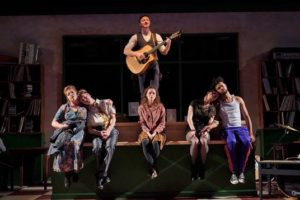The Taming of the Shrew @ Great Lakes, March 29-April 14, 2019
Review by Laura Kennelly
Director Sara Bruner’s The Taming of the Shrew at the Hanna Theatre brings a welcome fresh look, lots of insight, and--most importantly--plenty of laughs (it is, after all, a comedy). This Great Lakes production of the Shakespeare classic also boasts a dynamic cast, one that speaks clearly enough for jokes to be funny and moves quickly enough to keep us involved.
It’s a simple story set in Italy. Baptista Minola (Steve Pickering) insists that his oldest daughter (Katherine) must be married before the younger one may be allowed to be wed. (It’s actually to Katherine’s benefit because that way she will be taken care of when her father dies.) Bianca (Mandie Jenson) has three suitors and they are all smitten with the young woman they imagine is as sweet as she seems to be. Bianca fears she will never be married if she has to wait for Katherine to find a husband.
Rather than a battle between the sexes (or even stereotypes) as some directors would show it, Bruner shows us a battle between a very angry, rude woman (Katherine) who resents her situation and a self-confident adventurer (Petruchio) who wants to better his lot in life by marrying “up.” Bianca’s suitor, the dashing Hortensio (Eric Damon Smith) tells Petruchio the situation, but warns him Katherine is “difficult.” No problem, Petruchio says.
When Katherine (powerhouse Jessika D. Williams) marches on stage, Williams shows her as a terrifying “shrew.” Kate hits, throws, and yells at family, servants, and visitors whether they deserve it (some do) or not.
As the story continues (and after they are wed) Jonathan Dyrud’s stalwart Petruchio mirrors Kate’s temper to (ultimately) achieve an effective alliance. (One can only imagine what power the two united must have enjoyed in later life.) Dyrud, tall and confident, and Williams, also tall and confident, seem well-matched. Williams’ usurping of the famous “Kiss me Kate” command brings extra laughs.
The humor is broad and the farce gets frenetic (which I like). One highlight Friday night was Joe Wegner’s Grumio (a servant to Petruchio). I’m told Wegner varies his comic bit from performance to performance, but we saw him slide into the theatre from the audience (via a section divider) and then, reciting lines all the way, march through a center row of occupied seats (with an “excuse, pardon,” etc.) to the stage. After which he peered out into the audience saying “Hi, Tom Hanks!” Hammy, but hysterical.
The excellent ensemble (now the norm for GLT) included Lynn Robert Berg, Taha Mandviwala, David Anthony Smith, Maggie Kettering, Andy Nagraj, Ethan Hennes, M.A. Taylor, Krista Harmon, Nate John Mark, Jessie Cope Miller, and Jodi Dominick. Dominick, in disguise as father to one of Bianca’s suitors, also brought laughs with an outrageous Jersey accent straight out of “The Godfather.”
The set (designed by Russell Metheny) resembled an Elizabethan stage. In what may be a permanent practice, onstage seating (this time with seats onstage and seats on a balcony) also proved popular. (Kudos to the unknown audience member on Friday night who allowed himself to be crowned with a tin pot and reacted happily to the gentle sport made of him.)
Costume designer Leah Piehl created clothes for Kate that allowed her to look as rough as the men (boots and breeches) and elegant costumes for the more traditionally dressed characters. Jessie Cope Miller’s elegantly-gowned “Widow” looked rich compared to the practically gowned Kate, a fact which made one suspect that Petruchio desired the rigorous Kate for more than her money.
Bottom Line: In Shakespeare’s era “comedy” meant the play always had to end with a wedding. In this witty and gorgeous production, the wedding itself begins the laughs. Bravo Great Lakes (and thanks)!














